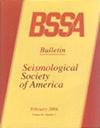Hard-Rock κ0 at KiK-Net Sites in Japan
IF 2.9
3区 地球科学
Q2 GEOCHEMISTRY & GEOPHYSICS
引用次数: 0
Abstract
Site-specific seismic hazard studies require the knowledge of the shear-wave velocity VS and the high-frequency site attenuation parameter κ0 at the reference rock level at depth. The latter one (called κ0,ref) is often not available and hard to derive. In this study, we make use of the KiK-net database in Japan that consists of surface and colocated downhole sensors. We select 175 sites where the bottom sensor is deployed at rock or hard-rock conditions resulting in a database with many recordings at VS≥1500 m/s. This allows us to tackle two questions: first, is it possible to derive κ0,ref from surface recordings? Second, does κ0 reach an asymptotic level at high VS that could be used as a κ0,ref in site-specific seismic hazard studies? Our results show that measures of κ0 derived from S and coda waves are equivalent. Thus, it is not possible to obtain κ0,ref from surface recordings using coda waves. On the other hand, S-wave measurements of κ0 from surface rock sites are close to κ0,ref if VS≥760 m/s or if the sedimentary cover is thin. The values of κ0 decrease with increasing VS and reach an asymptotic value. The scatter in the so obtained κ0,ref is high, but it can be reduced by selecting subregions with similar geological conditions. Finally, we observe that borehole and surface κ0 are correlated, and that the variability of κ0,ref is only slightly reduced compared to κ0 at the surface. Although we cannot exclude any influence of source effects, our findings indicate that κ0,ref has to be considered as a deep site parameter.日本KiK-Net网站的硬石κ0
特定场地的地震危险性研究需要了解纵深参考岩石水平处的横波速度VS和高频场地衰减参数κ0。后者(称为κ0,ref)通常不可用且难以推导。在这项研究中,我们使用了日本的KiK-net数据库,该数据库由地面和井下传感器组成。我们选择了175个地点,其中底部传感器部署在岩石或硬岩条件下,形成了一个数据库,其中包含许多VS≥1500 m/s的记录。这使我们能够解决两个问题:首先,是否有可能从地表记录中推导出κ0 ?其次,在高VS时,κ0是否达到渐近水平,可以用作特定地点地震危险性研究中的κ0 ?我们的结果表明,由S波和尾波得到的κ0值是等效的。因此,不可能从使用尾波的地表记录中获得κ0。另一方面,地表岩体的s波测量值在VS≥760 m/s或沉积层较薄的情况下接近于κ0。κ0值随VS的增大而减小,并趋于渐近。结果表明,该区域的散射系数较高,但可以通过选择地质条件相似的分区来减小散射系数。最后,我们观察到钻孔与地表的κ0是相关的,并且与地表的κ0相比,κ0的变异性仅略有降低。虽然我们不能排除任何源效应的影响,但我们的研究结果表明,κ0,ref必须被认为是一个深点参数。
本文章由计算机程序翻译,如有差异,请以英文原文为准。
求助全文
约1分钟内获得全文
求助全文
来源期刊

Bulletin of the Seismological Society of America
地学-地球化学与地球物理
CiteScore
5.80
自引率
13.30%
发文量
140
审稿时长
3 months
期刊介绍:
The Bulletin of the Seismological Society of America, commonly referred to as BSSA, (ISSN 0037-1106) is the premier journal of advanced research in earthquake seismology and related disciplines. It first appeared in 1911 and became a bimonthly in 1963. Each issue is composed of scientific papers on the various aspects of seismology, including investigation of specific earthquakes, theoretical and observational studies of seismic waves, inverse methods for determining the structure of the Earth or the dynamics of the earthquake source, seismometry, earthquake hazard and risk estimation, seismotectonics, and earthquake engineering. Special issues focus on important earthquakes or rapidly changing topics in seismology. BSSA is published by the Seismological Society of America.
 求助内容:
求助内容: 应助结果提醒方式:
应助结果提醒方式:


